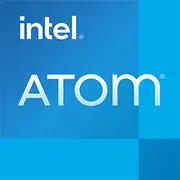Intel Atom D2500

Intel Atom D2500: A Modest Workhorse for Basic Tasks in 2025
Introduction
The Intel Atom D2500 processor, released back in 2011, continues to be in use in budget devices even in 2025. Despite its outdated architecture, it finds applications in niche scenarios. Let's explore who might benefit from this chip in the era of neural networks and quantum computing.
1. Architecture and Process Technology: Modest Ambitions
Cedarview: An Era of 32 nm
The Atom D2500 is based on the Saltwell microarchitecture (part of the Cedarview platform) with a 32 nm fabrication process. It is a dual-core processor with Hyper-Threading support (4 threads) operating at a base frequency of 1.86 GHz without turbo boost.
Integrated Graphics
The graphics accelerator is the Intel GMA 3600 (PowerVR SGX545), integrated into the NM10 chipset. It supports basic tasks such as screen output and 1080p video decoding via hardware codecs, but it is not designed for 3D rendering. Modern operating systems, like Windows 11 LTSC or Linux distributions, can run on it, albeit without interface hardware acceleration.
Cache and Memory
- L2 Cache: 1 MB;
- Memory support: DDR3-800/1066 (up to 4 GB).
2. Power Consumption and TDP: A Cool Head
The processor's TDP is 10 W, allowing for passive cooling. This is a key advantage of the Atom D2500:
- Low heat output — ideal for compact devices;
- Minimal noise — no fans needed;
- Energy savings — crucial for portable devices.
In 2025, such a TDP may seem archaic compared to Intel’s N-series processors (7 W) or ARM chips (3-5 W), but the D2500 remains energy-efficient for its category.
3. Performance: Realistic Expectations
Geekbench 6:
- Single-Core: 80;
- Multi-Core: 118.
For comparison, the modern budget Intel N100 (2023) scores around ~1200/3500 points.
Real-World Tasks:
- Office Work: LibreOffice, Google Docs, PDF viewing — acceptable, but with delays when multiple tabs are open.
- Multimedia: YouTube 1080p (with hardware acceleration), Spotify, photo viewing — no problems.
- Gaming: Only 2D games (Stardew Valley, Terraria) or older titles like Half-Life 2 on minimum settings (15-20 FPS).
Turbo Mode: Absent. The frequency is fixed, limiting peak performance.
4. Use Cases: Who Will Appreciate the D2500 in 2025?
- Netbooks for Education: Devices like the Chuwi Minibook X with a 10-inch screen priced at $200–250. Suitable for schoolchildren or students for text and browsing work.
- Terminals: POS systems, info kiosks, digital signage — due to low TDP and reliability.
- Backup Devices: A "just-in-case" laptop for travel (e.g., Jumper EZbook X3 for $220).
- Linux Enthusiasts: Lightweight distributions (Lubuntu, Puppy Linux) transform the D2500 into a quiet home server for file storage or VPN.
Not Suitable For:
- Gamers;
- Freelancers working with graphics;
- Windows 11 users with modern applications.
5. Battery Life: How Long Will the Battery Last?
With a battery capacity of 30–40 Wh (typical for netbooks), the working time reaches 6–8 hours in reading/video playback mode. However, in 2025, this is an average figure — competitors like the Snapdragon 7c Gen 3 offer over 12 hours.
Power-Saving Technologies:
- Enhanced Intel SpeedStep — dynamic frequency adjustment;
- C-states — disabling unused cores.
Tip: Disable Wi-Fi and lower the screen brightness to squeeze out an extra 1–2 hours.
6. Comparison with Competitors: Who is Leading?
- AMD A4-9120 (2019): 2 cores/2 threads, 15 W TDP, Radeon R3. Performance is about 20% higher, but battery life is worse.
- Intel Celeron N4500 (2021): 6 W TDP, 2 cores/2 threads, UHD Graphics. 2-3 times faster in multitasking.
- Apple M1 (2020): An indirect competitor, but even a base MacBook Air with M1 in 2025 outperforms the D2500 by 15 times in performance.
Conclusion: The D2500 lags behind even budget models from the 2020s but shines in pricing.
7. Pros and Cons: Balancing Capabilities
Pros:
- Device cost: $200–300;
- Silent operation;
- Sufficient for basic tasks.
Cons:
- No support for modern instructions (AVX, AES-NI);
- Maximum 4 GB RAM;
- Weak GPU;
- Outdated interfaces (SATA II, USB 2.0).
8. Recommendations for Choosing a Laptop
Types of Devices:
- Ultra-Budget Netbooks: For example, the Lenovo IdeaPad 1 with an 11.6" screen ($230).
- Mini-PCs: Beelink U55 for a media center.
What to Look For:
- SSD Instead of HDD: Even a 128 GB SATA SSD will speed up the system.
- Screen: An IPS panel with a resolution of 1366x768 is the minimum for comfort.
- Ports: Look for at least one USB 3.0 for external storage.
Prices in 2025: New devices with D2500 are rare but can be found among "no-name" brands for $200–250.
9. Final Conclusion: Who Should Consider the Atom D2500?
This processor is for those who:
- Are looking for the cheapest new device;
- Don’t require high performance (web surfing, document printing);
- Value quiet operation and long lifespan.
Key Benefits:
- Price below $300;
- Ease of maintenance;
- Compatibility with lightweight OS.
Alternative: If the budget allows for $350–400, consider laptops with Intel N100 or AMD Athlon Silver 7120U — they will last longer and not disappoint in performance.
The Atom D2500 in 2025 is a relic, but for narrow tasks, it remains a viable option. As a backup device or terminal, it will still serve a purpose, but for most users, there are fresher solutions available.
Basic
CPU Specifications
Memory Specifications
GPU Specifications
Benchmarks
Compared to Other CPU
Share in social media
Or Link To Us
<a href="https://cputronic.com/cpu/intel-atom-d2500" target="_blank">Intel Atom D2500</a>